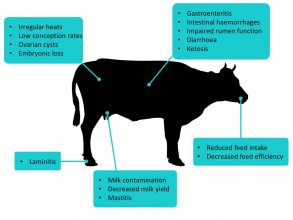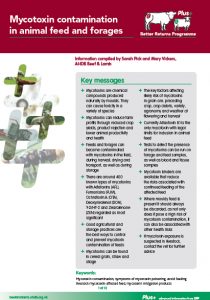Bovine Mycotoxicosis
Bovine mycotoxicosis is caused by cattle ingesting mycotoxins in their feed. There are many clinical signs of mycotoxicosis although they tend to be non-specific. The severity depends on the mycotoxin type, animal health, stage of production and dose eaten. Some types damage organs directly (e.g. liver, kidney and rumen), whilst others impair reproduction or cause cancer (Bryden, 2012).
Physical effects range from performance loss to mortality. Different mycotoxins can interact in the rumen to exacerbate the effect and some are known to suppress immune function (Fink-Gremmel, 2008). Signs of mycotoxicosis in ruminant animals include: loss of appetite, reduced milk yield or poor weight gain, feed refusal, diarrhoea, raised temperature, itchiness, bleeding and ill thrift (Krogh, 1978).
 The symptoms build gradually and include:
The symptoms build gradually and include:
•Depressed feed intake
•Reduced milk yield
•Diarrhoea
•Poor fertility
Early veterinary diagnosis of mycotoxicosis is difficult due to a lack of specific symptoms and overlapping symptoms of other metabolic diseases such as acidosis in cattle. Currently mycotoxicosis is generally characterized and diagnosed by the following features:
1.The disease is not contagious
2.Conventional medicines have little effect in controlling the disease
3.Outbreaks are often seasonal
4.The problem is associated with a specific feed
5.Analytical assay of the feed indicates the presence of mycotoxins.
The problem does not end in animal disease or production losses as mycotoxins in the feed of dairy animals can lead to the presence of their metabolic products in dairy products (Riahi-Zanjani and Balali-Mood, 2013), which pose a risk in human health.
What are mycotoxins?
Mycotoxins are fungal metabolites that can be present on grain, cereals, grass, conserved forage and even dust. Several environmental risk factors increase the likelihood of mycotoxins and mycotoxicosis (disease in animals caused by mycotoxin ingestion), including high rainfall at crop flowering and during pre-harvest. Wet growing and harvest seasons can result in high mycotoxin levels in grain.
Silage (whole crop (grain and straw), maize and grass) the main forage source for dairy and beef cattle represents a significant source of mycotoxins. A 2014 survey of silage and animal health conducted on farms in south west England did not detect mycotoxin contamination in any of 51 grass silage samples analysed. However, mycotoxins were found in 90% of maize silage samples (Cogan et al., 2016). It is likely that mycotoxins may have been produced in the field pre‐ensiling. Physical damage to maize ears in the field can significantly increase the mycotoxin concentrations at harvest. This can have serious implications for farms where damage to maize plants by deer or badgers is a regular occurrence.
Yeasts lie dormant in a silo, due to the lack of oxygen and low acidity. However, when a silo or bale is opened up and the silage is exposed to oxygen again, the yeasts revive and aerobic spoilage (rotting) occurs. This can then set off a succession of events, including the proliferation of aerobic bacteria and moulds, an increase in temperature and a resulting loss of digestible nutrients. This cascade of events can also culminate in the production of mycotoxins and visible mould is a strong indicator of the presence of mycotoxins.
- feed silage as soon as possible after removing it from the silo
- take care to avoid putting any spoiled silage in feed troughs.
- aim to offer a little more than the animals are likely to eat
- troughs should be cleaned out daily before being re-filled
- do not offer rejected silage to other livestock as it may be contaminated
References
Bryden, W.L. (2012). Mycotoxin contamination of the feed supply chain: Implications for animal productivity and feed security. Anim. Feed Sci. Technol. 173, 134–158.
Cogan, T, Hawkey, R., Higgie, E., Lee, MRF., Mee, E, Parfitt, D. Raj, J., Roderick, S., Walker, N., Ward, P and Wilkinson, J.M (2017) Silage and total mixed ration hygienic quality on commercial farms: Implications for animal production. Grass and Forage Science 72 (4): 601–613
Fink-Gremmels, J. (2008). The role of mycotoxins in the health and performance of dairy cows. Vet. J. Lond. Engl. 1997 176, 84–92.
Krogh, P. (1978). Mycotoxicoses of animals. Mycopathologia 65, 43–45.
Riahi-Zanjani, B., and Balali-Mood, M. (2013). Aflatoxin M1 contamination in commercial pasteurized milk from local markets in Fariman, Iran. Mycotoxin Res. 29, 271–274.


 American English
American English


Comments are closed.